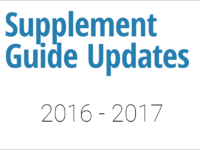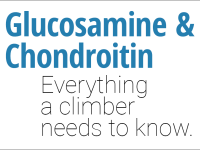Facts at a Glance
Summary
Caffeine improves mood and energy, increases focus and accuracy, and decreases pain and rates of perceived exertion. Non-users stand to gain the most when using it as an acute ergogenic aid for short-term events, such as competitions or projects, but even habitual users can experience benefits such as improved training quality.
Best For…
Competitions: 5/5
Sending Long-Term Projects: 5/5
Training (All Types): 3/5
Dosage
3 milligrams of caffeine per kilogram bodyweight
(1.36 milligrams per pound bodyweight)
Adverse Effects
Dose-dependent—adverse effects increase with dose, and should be mild in the recommended range. As dose increases, anxiety, jitteriness, and increased heart rate and blood pressure are common. When taken late in the day, caffeine can disturb normal sleep.
Caffeine withdrawal in habitual users can cause headaches, irritability, and low energy.
What Is Caffeine?
Caffeine is a methylxanthine alkaloid found naturally in a wide variety of common foods and drinks, including coffee, tea (Camellia sinensis, not herbal), chocolate, yerba mate, and kola nuts. Its primary and best-known effect is the stimulation of the central nervous system.
Most adults have experienced caffeine’s positive effects, which include alertness and focus as well as improvements in energy and mood. Of course, these effects can come with a price: caffeine can increase blood pressure, cause anxiety, lead to jitters, and disturb sleep when consumed late in the day. For habitual users, caffeine withdrawal can cause sluggishness, sleepiness, foul moods, and headaches.
Along with being the most commonly consumed drug in the world, caffeine is also one of the most effective acute ergogenic aids. Improved focus, energy, and mood all have the capability of significantly increasing performance, and consistently do under study conditions. Meta-analyses and systematic reviews conclude that caffeine has ergogenic properties for both high-intensity and endurance exercise,1–5 though they don’t always agree on why or how much.
Mode of Action
Caffeine has one major, well-evidenced mode of action, but there is some debate about whether there are other modes as well or whether those other modes are mediated through the primary mode.
Primary: Adenosine Receptor Antagonism
Caffeine’s primary mode of action is that of an adenosine receptor antagonist—the caffeine molecule blocks the effects of adenosine thereby dampening adenosine’s effects, which include reducing heart rate, dilating (widening) blood vessels, and inhibiting central nervous system “excitement”. Thus, it should come as no surprise that caffeine stimulates excitement of the nervous system, constricts blood vessels, and increases heart rate.
These are only the most direct effects, however; the blockade of adenosine causes numerous, less immediately obvious downstream effects as well by altering the concentrations of other neurotransmitters and hormones, such as dopamine and norepinephrine (adrenaline). Many of these effects are well-understood, but the complicated nature of their mechanism can lead to misunderstandings about the origin of some of caffeine’s effect. As such, we remain uncertain about whether caffeine does more than just act as an adenosine receptor antagonist, even though we’re certain this is far and away the most clinically significant way it affects us.
Possible: Muscular Effects
If caffeine affects something outside the central nervous system, it’s likely to be the muscles—at least so far as exercise performance is concerned. Some research appears to demonstrate a local effect of caffeine in the muscles, 6–8 specifically increasing force and possibly mediated through increased sodium/potassium pump action or increased calcium release. On the other hand, other researchers have argued that these effects can still be traced to the central nervous system,9 so the debate remains. At any rate, if there are local effects, they account for less than 1% of caffeine’s ergogenic effects and are more of academic interest that anything.
Beneficial Effects
Caffeine has several beneficial effects: some direct, and others consequential to those. The direct effects relate to caffeine’s action as an adenosine receptor antagonist, while the latter beneficial effects leave room for local effects (if they indeed exist).
Rate of Perceived Exertion & Pain (Direct)
One of caffeine’s most well-documented beneficial effects is decreased pain and improved rate of perceived exertion.3,5,10–32 By reducing a person’s sensitivity to pain, they can exercise harder and for longer than they normally would be able.
Perceived exertion is more than just a subjective measure of exercise intensity, it is also a feedback mechanism between the brain and body. Factors such as hot temperatures, muscular pain, and anxiety (e.g., fear of falling) can increase perceived exertion and cause our brain to limit our muscles to prevent overexertion, thereby decreasing performance. In the same way, when caffeine decreases our perceived rate of exertion, our brain allows the muscles to work harder, increasing performance.
The decrease in perceived exertion induced by caffeine is most likely related to the decreased sensitivity to exercise-related pain—think of burning forearms, not broken bones. In turn, this decreased pain sensitivity is likely related to improvements in mood, as will be discussed next.
Mood & Vigor (Direct)
In addition to reducing exercise-associated pain and perceived exertion, caffeine also improves mood and “vigor”,14,33–36 a somewhat nebulously defined term that ties together energy, pleasure, and motivation to exercise. Essentially, caffeine makes you happier and happier to be exercising.
Since pain perception is known to be correlated with happiness, the decrease in pain sensitivity is likely correlated with improvements in mood. At any rate, it’s unlikely caffeine acts locally on pain receptors or blocks pain signal transmission. Even aside from pain reduction, however, there is merit to simply being “happier” while exercising, and the resultant improved vigor should not be downplayed.
Skill & Focus (Direct)
Caffeine has well-known effects on mental acuity, as anyone cramming for a midterm knows well. This increase in focus has important effects for skill-based exercises (including climbing), too.
For athletes, caffeine can improve accuracy and “readiness to invest effort”, or the willingness to actually go for it and perform at maximal effort.28,37–39 Climbers with increased focus may be able to more accurately deadpoint, dyno, and otherwise perform high-intensity, accuracy-dependent moves.
Strength & Power (Secondary)
Both strength and power are significantly increased by caffeine.10,11,16,40–58 Major effects include: increased reps to failure,10,11,51,52,56 improved sprint performance,40–42,47,48,55,57 and attenuated reductions in overall power.16,44,45,53,59 Some studies also note an increase in maximal strength, power, or both.16,43,49,56 While no study has directly examined caffeine’s effect on climbing, we can extrapolate that the improved power and power endurance witnessed in resistance training and sprint trials would also be seen in climbers.
Not all studies are positive; some fail to show a beneficial effect. When an effect is failed to be seen, it is usually related to what was tested or how the testing was done. Specifically, caffeine does not appear to benefit one-rep maxes (including vertical jump height)60,61 or repeat sprint performance during multiple sessions without adequate rest.50,62,63 In other words, caffeine cannot overcome performance problems stemming from inadequate recovery.
Endurance (Secondary)
Caffeine improves endurance exercise performance in two notable ways: by improving pacing (making an athlete run, cycle, or swim faster),35,64–70 and by increasing time to exhaustion (allowing an athlete to exercise longer).25,71–73 These are two sides of the same coin—on the one side, we see athletes who are time-constrained able to put more energy into those minutes; on the other side, we see athletes who are power-constrained (time trials are usually paced) able to run for significantly longer. The result of both is that more work can be done by the athlete.
Fat Metabolism
Caffeine is known to increase the release of free fatty acids from fat tissue,32,74–78 but unfortunately it does not seem to also increase the oxidation (or burning) of those fatty acids.75–79 What does this mean? Essentially, it indicates that while caffeine does indeed cause increased fatty acid release, it cannot directly affect our metabolism or force our body to use that available energy in situations where it would not normally be using it anyway.
If that doesn’t make sense, think of it like this: Your fat tissue is like a bank account, and whenever you need money (energy) from that account you make a withdrawal. In most circumstances, you have no problem withdrawing the money you need whenever you need it. Caffeine makes that money even more available by withdrawing it to cash in your pocket, but that by itself isn’t enough to make you spend that cash—you still need the stimulus to spend it in the first place.
It should be noted that this only applies to caffeine by itself—caffeine is a drug and interacts with other drugs in ways that are sometimes synergistic or complementary. The best examples of this are green tea catechins, which appear to increase fat oxidation (but not mobilization). Either caffeine or catechins by themselves do little to increase total daily fat oxidation, but combined they are effective80—though it’s still questionable as to the size of the effect, and whether it would significantly affect short- or long-term weight loss.
What Affects Caffeine’s Benefits?
Caffeine is a drug, and as such its effects can be attenuated or otherwise altered by several factors:
Habituation
The most common way caffeine’s effectiveness can be altered is by habituation, a process through which the body becomes accustomed to the caffeine molecule causing it to be less effective. It’s clear that habituation decreases or eliminates some of the caffeine’s benefits, but it’s not as clear how much of an effect habituation has on performance—some studies done on the differences in performance between habitual users and non-users have found no difference,81–83 while others have found some.82,84–86
In the end, we have enough evidence to state habitual users still benefit from caffeine use during exercise—though perhaps the benefits will be more transient or less powerful. On the other hand, if you’re competing or planning a trip around a project, it may be worthwhile to withdraw from caffeine for at least a week prior to your competition or trip so as to reap the maximum benefit, just to be safe.
Genetics
Caffeine clearance is strongly affected by genetics, specifically the CYP1A2 gene. Most people are homozygous for the “A” allele (AA), and are “normal” caffeine metabolizers—neither fast nor slow. Some people carry a “C” allele, though, and are “slow” caffeine metabolizers. For these individuals, caffeine will have a stronger effect since it is cleared from the system more slowly.
For exercise performance, genetics don’t appear to have a strong influence, though slow metabolizers may be more susceptible to adverse effects.87 It should be noted that with only a single study done on the topic, we can hardly call this a solid conclusion—but it’s likely that if genotype does affect caffeine and exercise performance, it’ll be in regards to timing and dose, not ergogenic effects.
Tobacco Use
Smokers have increased rates of caffeine clearance compared to non-smokers.88 Similar to genetics, this should not affect caffeine’s overall ergogenicity but rather just the timing and dose.
Adverse Effects
Caffeine has several well-documented adverse effects, both acute and chronic:
Acute Effects
When consumed in excess amounts, caffeine can cause overstimulation of the central nervous system, leading to effects both mild and severe depending on the size of the overdose. On the lower end, caffeine can cause anxiety, jitters, difficulty sleeping, and increased blood pressure. In extreme doses (greater than 10 grams, or the equivalent of roughly 7 gallons [26 liters] of coffee) caffeine is fatal.
While the mild adverse effects of caffeine are common, serious complications and death are exclusively seen in individuals who have supplemented with loose powdered caffeine. It takes less than a tablespoon of caffeine to cause serious harm or death, and as a tasteless, odorless white powder it can be easy to accidentally take this amount—especially if caffeine is just one of several tasteless, odorless white powders in your supplement cabinet! For this reason, I strongly recommend AGAINST the purchase or use of loose caffeine powder. If you choose to buy a caffeine supplement, purchase tablets or capsules, which are significantly harder to accidentally overdose with.
Chronic (Withdrawal) Effects
Habituated users who stop consuming caffeine will experience several common withdrawal effects, including irritability, decreased energy, and headaches. These effects are strongest the first couple days of caffeine withdrawal and will dissipate gradually over the course of a week. To avoid these effects, it’s possible to withdraw from caffeine slowly by reducing your daily intake over the course of a few weeks. For those going the cold turkey route, painkillers can soothe headaches, reducing pain and improving mood, but nothing (outside of another stimulant) will improve your energy.
Effects on Pregnancy
This topic is mostly outside the scope of this article, but I would be remiss if I didn’t at least mention it. There is little high-quality evidence on whether caffeine should be avoided completely, partially, or at all during pregnancy—or on the effects of any of these choices—but despite this, there are still plenty of misconceptions surrounding the risks of caffeine in pregnancy.89–92
Currently, the American Congress of Obstetricians and Gynecologists recommends pregnant women to consume less than 200 milligrams of caffeine daily, or the equivalent of 16 ounces (500 milliliters) of coffee (though they also say a final recommendation cannot yet be made given the data).93 If you are pregnant, you should speak with your doctor, follow the above recommendation, or both.
Diuresis & Dehydration
Caffeine is commonly thought to cause diuresis, or increased urination. There isn’t strong evidence to back this claim, however, at least at the levels commonly consumed.94–96 If you seem to pee more after consuming caffeine, it’s due to the increased liquid consumption that accompanies caffeine intake. There is no evidence that caffeine will cause dehydration or increase the risk of dehydration in athletes (or anyone).
Dosage
In studies on athletic performance, caffeine is usually dosed at either 3 milligrams per kilogram of bodyweight (1.36 milligrams per pound) or 6 milligrams per kilogram of bodyweight (2.72 milligrams per pound). For most people, this is equivalent to an effective dose range of 150 to 500 milligrams—quite a large range.
In studies that compare the relative efficacy of 3 vs. 6 milligrams per kilogram bodyweight, there is no advantage to doses above 3 milligrams.97–99 On the other hand, doses below 2 milligrams per kilogram bodyweight may be less effective,97,99 so there is a threshold.
As more studies are done on genotype and caffeine metabolism, we may discover that some individuals respond better to greater or lesser doses. In the meantime, 3 milligrams per kilogram bodyweight (1.36 milligrams per pound) appears to be sufficient to derive full benefits—there is no need to consume more.
Legality
Caffeine is legal, including for use in sanctioned climbing (and other athletic) events. However, there is an upper limit for caffeine in drug tests, which varies from 12-15 mcg/L (in the athlete’s urine) depending on the organization (none are lower)—this is equivalent to consuming more than 9 milligrams of caffeine per kilogram bodyweight, or three times the effective dose. Thus, while caffeine can flag a drug test, you would need to severely overdo it.
There is some talk about the World Anti-Doping Agency (WADA) adding caffeine to its banned list, but since they recognize that caffeine is a commonly consumed drug with little risk of dangerous adverse effects, this “ban” is more likely to simply be a reduction in the threshold for a flagged drug test. Given that only 16 ounces (about 500 milliliters) of coffee is enough to derive an ergogenic benefit from, and that this is a common amount of coffee to consume (for Americans, anyway), I doubt the WADA will be able to justify setting the threshold to below the amount necessary for performance benefits, and thus is a null issue.
How to Choose the Right Product
Unlike nearly all the other supplements I recommend, caffeine comes in effective doses in many liquids we already drink, so there is less to say about “choosing the right product”. Coffee, tea, or any other caffeinated food or beverage are all effective means of getting your caffeine.
For reference, here are the caffeine contents of common beverages:
| Beverage | Serving Size | Caffeine Content |
| Decaffeinated Tea | 8 oz (236 mL) | 5 mg |
| Decaffeinated Coffee | 8 oz (236 mL) | 2-10 mg |
| Green Tea | 8 oz (236 mL) | 30 mg |
| Black Tea | 8 oz (236 mL) | 50 mg |
| Drip Coffee | 8 oz (236 mL) | 60-80 mg |
| Espresso | 1 oz (30 mL) | 40-50 mg |
The above should be used as estimates only, as the actual caffeine content will vary naturally depending not only on the product itself but also preparation (e.g., strength of brew). Other caffeine-containing products such as energy drinks and sodas should have their caffeine contents listed on the label.
Supplements
If you would rather use supplements, either because you don’t commonly consume caffeinated beverages or because you want accuracy in your dose, then I strongly recommend purchasing tablets or capsules and NOT POWDERS! Caffeine is lethal in relatively small measured amounts (less than a tablespoon), and since it is an odorless, colorless powder it can be easy to accidentally take too much if you are not paying attention. This is much less common with capsules and tablets.
When purchasing supplements in general, go with a trusted manufacturer. If you are a competitor who may be subjected to a drug test, I recommend purchasing a product backed by Informed Choice or Informed Sport, which are independent testing organizations that manufacturers pay to randomly test and guarantee their products against adulteration. On each of the above sites, there is a list of products that are backed so you can make a good choice.
For non-competitive athletes looking for a high-quality product at a good price, I highly recommend TrueNutrition.com—a bulk supplier of sports nutrition supplies. In truth, I would be surprised if any of TrueNutrition.com’s products are adulterated with illicit substances because they supply direct from the manufacturers, and the manufacturers have no incentive to corrupt their pure products—but if you’re a high-level athlete, it’s still a risk you should weigh against the increased price of a guaranteed product.
If you do shop from TrueNutrition.com, you can use the code BNRY639 to get 5% off. Once upon a time I was supposed to get a bit of kickback from this, but I don’t think that function exists anymore (I’ve never seen any money from it, anyway) so I supply the code solely in good faith that you’ll get a discount! Be sure to check their promo page as well, as there may be better deals and you only get to choose one.
Conclusion
Caffeine is probably the most effective (legal) acute ergogenic aid an athlete can use. While supplements like creatine and beta-alanine may cause a greater overall long-term benefit when used consistently, the effects of caffeine can be experienced immediately.
Since caffeine habituation may cause a decrease in its ergogenicity, the best use for caffeine is as a boost in the occasional, high-reward situation—competitions, projects, etc. Caffeine could also be used more habitually for improved training, but since this carries the price of habituation, it must be weighed carefully; when timed properly, caffeine will improve your training quality, but it may also worsen the quality of your training if you do not time caffeine correctly or try to train without caffeine while habituated. Also, habituation carries general advantages and disadvantages in day-to-day life that cannot be ignored.
The bottom line is that caffeine is an extremely effective ergogenic aid, but one that carries some noticeable adverse effects. Since caffeine intake is a daily habit for many people, this article may do little except inform on the benefits and drawbacks. If you are not a caffeine user, however, you definitely stand to benefit from adding it to your supplement drawer.














Awesome article, thanks for posting! I rarely use caffeine and find that when I take it, ~100mg is enough to put me on edge. That’s about half of a 3mg/kg dose. It does help me get psyched to train, but I think it hurts my actual climbing performance. A big part of climbing aptitude is the capacity to maintain your calmness and poise, and I think caffeine generally works against that goal. Maybe some people can harness the increased energy and channel it in a way that works, but for me the jitters overshadow any positive effects.
For sure, caffeine is one of the more “personal experience”-oriented ergogenic aids—it’s also an actual drug (unlike most of the supplements I’ve thus far reviewed, which are nutrients), and has drug-like effects that may or may not agree with everyone!
It’s great that you pointed out how decreased pain and improved rate of perceived exertion are some of caffeine’s most well-documented beneficial effects. I was reading an article about supplements earlier and I learned about the effects of caffeine on the body. From what I’ve read, it seems there are plenty of caffeine sport supplements available now.